Emotion Recognition from ECG Signals Using Wavelet Scattering and Machine Learning
Abstract
:1. Introduction
Background
2. Materials and Methods
2.1. Dataset
2.2. Algorithm Overview
2.3. Data Processing
2.4. Feature Extraction
2.4.1. Time Domain Features
2.4.2. Frequency Domain Features
2.4.3. Wavelet Scattering Features
2.5. Dimensionality Reduction
2.6. Classification Methods
2.7. Validation Methods
3. Results
3.1. Data Processing
3.2. Extracted Features
3.3. Classification in One Dimension
3.4. Classification in Two Dimensions
3.5. Short Experiment Result Comparison
4. Discussion
4.1. Algorithm Performance for Valence and Arousal
4.2. Classification Performance in Two Dimensions
4.3. Scattering Window Classification Performance
4.4. Short Experiment Result Comparison
4.5. LOSO Validation
5. Conclusions and Future Work
Author Contributions
Funding
Data Availability Statement
Conflicts of Interest
References
- Russell, J.A. A circumplex model of affect. J. Personal. Soc. Psychol. 1980, 39, 1161. [Google Scholar] [CrossRef]
- Basu, S.; Jana, N.; Bag, A.; Mahadevappa, M.; Mukherjee, J.; Kumar, S.; Guha, R. Emotion recognition based on physiological signals using valence-arousal model. In Proceedings of the 2015 Third International Conference on Image Information Processing (ICIIP), Waknaghat, India, 21–24 December 2015; pp. 50–55. [Google Scholar] [CrossRef]
- Shu, L.; Xie, J.; Yang, M.; Li, Z.; Li, Z.; Liao, D.; Xu, X.; Yang, X. A Review of Emotion Recognition Using Physiological Signals. Sensors 2018, 18, 2074. [Google Scholar] [CrossRef] [Green Version]
- Goshvarpour, A.; Abbasi, A.; Goshvarpour, A. An accurate emotion recognition system using ECG and GSR signals and matching pursuit method. Biomed. J. 2017, 40, 355–368. [Google Scholar] [CrossRef]
- Koelstra, S.; Mühl, C.; Soleymani, M.; Lee, J.S.; Yazdani, A.; Ebrahimi, T.; Pun, T.; Nijholt, A.; Patras, I. DEAP: A Database for Emotion Analysis Using Physiological Signals. IEEE Trans. Affect. Comput. 2011, 3, 18–31. [Google Scholar] [CrossRef] [Green Version]
- Soleymani, M.; Lichtenauer, J.; Pun, T.; Pantic, M. A Multi-Modal Affective Database for Affect Recognition and Implicit Tagging. Affect. Comput. IEEE Trans. 2012, 3, 1. [Google Scholar] [CrossRef] [Green Version]
- Miranda Correa, J.A.; Abadi, M.K.; Sebe, N.; Patras, I. AMIGOS: A Dataset for Affect, Personality and Mood Research on Individuals and Groups. IEEE Trans. Affect. Comput. 2018. [Google Scholar] [CrossRef] [Green Version]
- Kahou, S.E.; Bouthillier, X.; Lamblin, P.; Gulcehre, C.; Michalski, V.; Konda, K.; Jean, S.; Froumenty, P.; Dauphin, Y.; Boulanger-Lewandowski, N.E.A. EmoNets: Multimodal deep learning approaches for emotion recognition in video. J. Multimodal User Interfaces 2015, 10, 99–111. [Google Scholar] [CrossRef] [Green Version]
- Kossaifi, J.; Tzimiropoulos, G.; Todorovic, S.; Pantic, M. AFEW-VA database for valence and arousal estimation in-the-wild. Image Vis. Comput. 2017, 65, 23–36. [Google Scholar] [CrossRef]
- Dhall, A.; Goecke, R.; Joshi, J.; Hoey, J.; Gedeon, T. Emotiw 2016: Video and group-level emotion recognition challenges. In Proceedings of the 18th ACM international conference on multimodal interaction, Tokyo, Japan, 12–16 November 2016; pp. 427–432. [Google Scholar]
- Ranganathan, H.; Chakraborty, S.; Panchanathan, S. Multimodal emotion recognition using deep learning architectures. In Proceedings of the 2016 IEEE Winter Conference on Applications of Computer Vision (WACV), Lake Placid, NY, USA, 7–10 March 2016. [Google Scholar] [CrossRef]
- Fan, Y.; Lu, X.; Li, D.; Liu, Y. Video-based emotion recognition using CNN-RNN and C3D hybrid networks. In Proceedings of the 18th ACM International Conference on Multimodal Interaction-ICMI 2016, Tokyo, Japan, 12–16 November 2016. [Google Scholar] [CrossRef]
- Hu, M.; Wang, H.; Wang, X.; Yang, J.; Wang, R. Video facial emotion recognition based on local enhanced motion history image and CNN-CTSLSTM networks. J. Vis. Commun. Image Represent. 2019, 59, 176–185. [Google Scholar] [CrossRef]
- Lucey, P.; Cohn, J.F.; Kanade, T.; Saragih, J.; Ambadar, Z.; Matthews, I. The extended Cohn-Kanade dataset (ck+): A complete dataset for action unit and emotion-specified expression. In Proceedings of the 2010 IEEE Computer Society Conference on Computer Vision and Pattern Recognition-Workshops, San Francisco, CA, USA, 13–18 June 2010; pp. 94–101. [Google Scholar]
- Valstar, M.; Pantic, M. Induced disgust, happiness and surprise: An addition to the mmi facial expression database. In Proceedings of the 3rd International Workshop on EMOTION (Satellite of LREC): Corpora for Research on Emotion and Affect, Paris, France, 3–6 September 2010; p. 65. [Google Scholar]
- Zheng, W.L.; Dong, B.N.; Lu, B.L. Multimodal emotion recognition using EEG and eye tracking data. In Proceedings of the 2014 36th Annual International Conference of the IEEE Engineering in Medicine and Biology Society, Chicago, IL, USA, 26–30 August 2014. [Google Scholar] [CrossRef]
- Alhagry, S.; Aly, A.; El-Khoribi, R. Emotion Recognition based on EEG using LSTM Recurrent Neural Network. Int. J. Adv. Comput. Sci. Appl. 2017, 8, 355–358. [Google Scholar] [CrossRef] [Green Version]
- Bălan, O.; Moise, G.; Petrescu, L.; Moldoveanu, A.; Leordeanu, M.; Moldoveanu, F. Emotion Classification Based on Biophysical Signals and Machine Learning Techniques. Symmetry 2020, 12, 21. [Google Scholar] [CrossRef] [Green Version]
- Paszkiel, S. Characteristics of question of blind source separation using Moore-Penrose pseudoinversion for reconstruction of EEG signal. In International Conference on Automation; Springer: Berlin/Heidelberg, Germany, 2017; pp. 393–400. [Google Scholar]
- Hsu, Y.; Wang, J.; Chiang, W.; Hung, C. Automatic ECG-Based Emotion Recognition in Music Listening. IEEE Trans. Affect. Comput. 2020, 11, 85–99. [Google Scholar] [CrossRef]
- Chicco, D.; Jurman, G. The advantages of the Matthews correlation coefficient (MCC) over F1 score and accuracy in binary classification evaluation. BMC Genom. 2020, 21, 6. [Google Scholar] [CrossRef] [Green Version]
- Katsigiannis, S.; Ramzan, N. DREAMER: A Database for Emotion Recognition Through EEG and ECG Signals From Wireless Low-cost Off-the-Shelf Devices. IEEE J. Biomed. Health Inform. 2018, 22, 98–107. [Google Scholar] [CrossRef] [Green Version]
- Harper, R.; Southern, J. A Bayesian Deep Learning Framework for End-To-End Prediction of Emotion from Heartbeat. IEEE Trans. Affect. Comput. 2020. [Google Scholar] [CrossRef] [Green Version]
- Ferdinando, H.; Seppänen, T.; Alasaarela, E. Comparing features from ECG pattern and HRV analysis for emotion recognition system. In Proceedings of the 2016 IEEE Conference on Computational Intelligence in Bioinformatics and Computational Biology (CIBCB), Chiang Mai, Thailand, 5–7 October 2016; pp. 1–6. [Google Scholar] [CrossRef] [Green Version]
- Santamaria-Granados, L.; Munoz-Organero, M.; Ramirez-Gonzalez, G.; Abdulhay, E.; Arunkumar, N. Using Deep Convolutional Neural Network for Emotion Detection on a Physiological Signals Dataset (AMIGOS). IEEE Access 2019, 7, 57–67. [Google Scholar] [CrossRef]
- Sarkar, P.; Etemad, A. Self-Supervised Learning for ECG-Based Emotion Recognition. In Proceedings of the ICASSP 2020-2020 IEEE International Conference on Acoustics, Speech and Signal Processing (ICASSP), Barcelona, Spain, 4–8 May 2020; pp. 3217–3221. [Google Scholar]
- Tung, K.; Liu, P.K.; Chuang, Y.C.; Wang, S.H.; Wu, A.Y. Entropy-Assisted Multi-Modal Emotion Recognition Framework Based on Physiological Signals. In Proceedings of the 2018 IEEE-EMBS Conference on Biomedical Engineering and Sciences (IECBES), Sarawak, Malaysia, 3–6 December 2018; pp. 22–26. [Google Scholar]
- Kolodyazhniy, V.; Kreibig, S.; Gross, J.; Roth, W.; Wilhelm, F. An affective computing approach to physiological emotion specificity: Toward subject-independent and stimulus-independent classification of film-induced emotions. Psychophysiology 2011, 48, 908–922. [Google Scholar] [CrossRef]
- Sarkar, P.; Etemad, A. Self-supervised ECG Representation Learning for Emotion Recognition. IEEE Trans. Affect. Comput. 2020. [Google Scholar] [CrossRef]
- Siddharth, S.; Jung, T.; Sejnowski, T.J. Utilizing Deep Learning Towards Multi-modal Bio-sensing and Vision-based Affective Computing. IEEE Trans. Affect. Comput. 2019. [Google Scholar] [CrossRef] [Green Version]
- Kim, H.Y. Statistical notes for clinical researchers: Chi-squared test and Fisher’s exact test. Restor. Dent. Endod. 2017, 42, 152. [Google Scholar] [CrossRef]
- Frésard, M.E.; Erices, R.; Bravo, M.L.; Cuello, M.; Owen, G.I.; Ibáñez, C.; Rodriguez-Fernandez, M. Multi-objective optimization for personalized prediction of venous thromboembolism in ovarian cancer patients. IEEE J. Biomed. Health Inform. 2019, 24, 1500–1508. [Google Scholar] [CrossRef]
- Kotsiantis, S.; Kanellopoulos, D.; Pintelas, P. Handling imbalanced datasets: A review. GESTS Int. Trans. Comput. Sci. Eng. 2005, 30, 25–36. [Google Scholar]
- Piskorski, J.; Guzik, P. Filtering Poincareplots. Comput. Methods Sci. Technol. 2005, 11, 39–48. [Google Scholar] [CrossRef]
- Luo, D.; Pan, W.; Li, Y.; Feng, K.; Liu, G. The interaction analysis between the sympathetic and parasympathetic systems in CHF by using transfer entropy method. Entropy 2018, 20, 795. [Google Scholar] [CrossRef] [Green Version]
- Strüven, A.; Holzapfel, C.; Stremmel, C.; Brunner, S. Obesity, Nutrition and Heart Rate Variability. Int. J. Mol. Sci. 2021, 22, 4215. [Google Scholar] [CrossRef] [PubMed]
- Daubechies, I.; Heil, C. Ten Lectures on Wavelets. Comput. Phys. 1992, 6, 697. [Google Scholar] [CrossRef] [Green Version]
- Mallat, S. Group Invariant Scattering. Commun. Pure Appl. Math. 2012, 65, 1331–1398. [Google Scholar] [CrossRef] [Green Version]
- Anden, J.; Mallat, S. Deep Scattering Spectrum. IEEE Trans. Signal Process. 2014, 62, 4114–4128. [Google Scholar] [CrossRef] [Green Version]
- Bruna, J.; Mallat, S. Invariant Scattering Convolution Networks. IEEE Trans. Pattern Anal. Mach. Intell. 2013, 35, 1872–1886. [Google Scholar] [CrossRef] [Green Version]
- Mallat, S. A theory for multiresolution signal decomposition: The wavelet representation. IEEE Trans. Pattern Anal. Mach. Intell. 1989, 11, 674–693. [Google Scholar] [CrossRef] [Green Version]
- James, G.; Witten, D.; Hastie, T.; Tibshirani, R. An Introduction to Statistical Learning; Springer: New York, NY, USA, 2013; Volume 112. [Google Scholar]
- Tharwat, A.; Gaber, T.; Ibrahim, A.; Hassanien, A.E. Linear discriminant analysis: A detailed tutorial. AI Commun. 2017, 30, 169–190. [Google Scholar] [CrossRef] [Green Version]
- Vishwanath, M.; Jafarlou, S.; Shin, I.; Lim, M.M.; Dutt, N.; Rahmani, A.M.; Cao, H. Investigation of machine learning approaches for traumatic brain injury classification via EEG assessment in mice. Sensors 2020, 20, 2027. [Google Scholar] [CrossRef] [Green Version]
- Khanna, D.; Sharma, A. Kernel-based naive bayes classifier for medical predictions. In Intelligent Engineering Informatics; Springer: Berlin/Heidelberg, Germany, 2018; pp. 91–101. [Google Scholar]
- Zhang, S.; Li, X.; Zong, M.; Zhu, X.; Cheng, D. Learning k for knn classification. ACM Trans. Intell. Syst. Technol. (TIST) 2017, 8, 1–19. [Google Scholar]
- Ghaddar, B.; Naoum-Sawaya, J. High dimensional data classification and feature selection using support vector machines. Eur. J. Oper. Res. 2018, 265, 993–1004. [Google Scholar] [CrossRef]
- Truong, X.L.; Mitamura, M.; Kono, Y.; Raghavan, V.; Yonezawa, G.; Truong, X.Q.; Do, T.H.; Tien Bui, D.; Lee, S. Enhancing prediction performance of landslide susceptibility model using hybrid machine learning approach of bagging ensemble and logistic model tree. Appl. Sci. 2018, 8, 1046. [Google Scholar] [CrossRef] [Green Version]
- Wong, T.T.; Yeh, P.Y. Reliable accuracy estimates from k-fold cross validation. IEEE Trans. Knowl. Data Eng. 2019, 32, 1586–1594. [Google Scholar] [CrossRef]
- Saeb, S.; Lonini, L.; Jayaraman, A.; Mohr, D.C.; Kording, K.P. The need to approximate the use-case in clinical machine learning. Gigascience 2017, 6, gix019. [Google Scholar] [CrossRef] [Green Version]
- Gholamiangonabadi, D.; Kiselov, N.; Grolinger, K. Deep Neural Networks for Human Activity Recognition With Wearable Sensors: Leave-One-Subject-Out Cross-Validation for Model Selection. IEEE Access 2020, 8, 133982–133994. [Google Scholar] [CrossRef]
- Liu, Z.; Yao, G.; Zhang, Q.; Zhang, J.; Zeng, X. Wavelet Scattering Transform for ECG Beat Classification. Comput. Math. Methods Med. 2020, 2020, 3215681. [Google Scholar] [CrossRef] [PubMed]
- Ferdinando, H.; Ye, L.; Seppänen, T.; Alasaarela, E. Emotion Recognition by Heart Rate Variability. Aust. J. Basic Appl. Sci. 2014, 8, 50–55. [Google Scholar]
- Mert, A.; Kilic, N.; Akan, A. ECG signal classification using ensemble decision tree. J. Trends. Dev. Mach. Assoc. Technol. 2012, 16, 179–182. [Google Scholar]
- Paszkiel, S.; Hunek, W.; Shylenko, A. Project and Simulation of a Portable Device for Measuring Bioelectrical Signals from the Brain for States Consciousness Verification with Visualization on LEDs. In International Conference on Automation; Springer: Berlin/Heidelberg, Germany, 2016; pp. 25–35. [Google Scholar]
- Phinyomark, A.; Limsakul, C.; Phukpattaranont, P. Application of wavelet analysis in EMG feature extraction for pattern classification. Meas. Sci. Rev. 2011, 11, 45. [Google Scholar] [CrossRef]
- Arozi, M.; Caesarendra, W.; Ariyanto, M.; Munadi, M.; Setiawan, J.D.; Glowacz, A. Pattern recognition of single-channel sEMG signal using PCA and ANN method to classify nine hand movements. Symmetry 2020, 12, 541. [Google Scholar] [CrossRef] [Green Version]

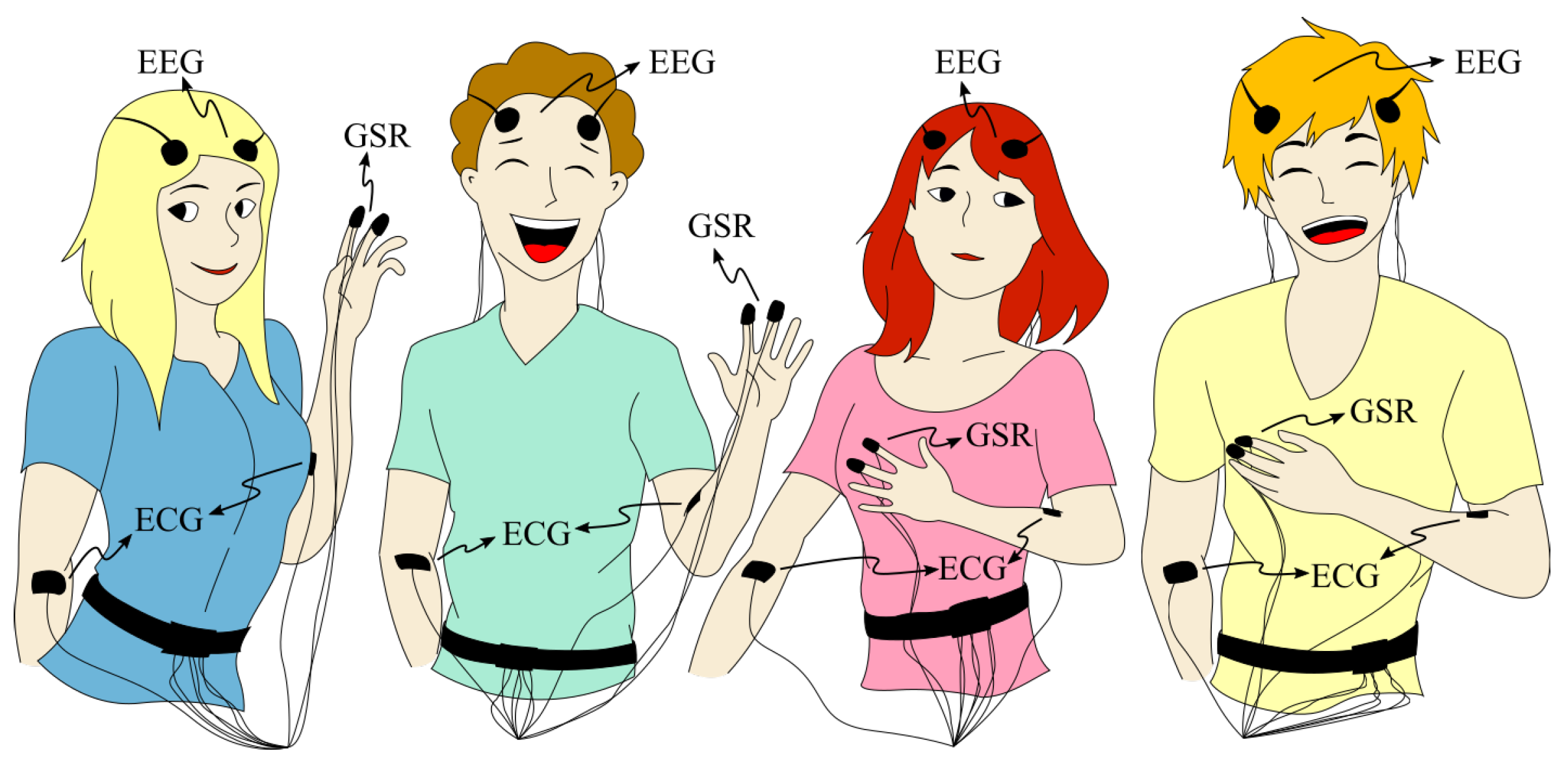

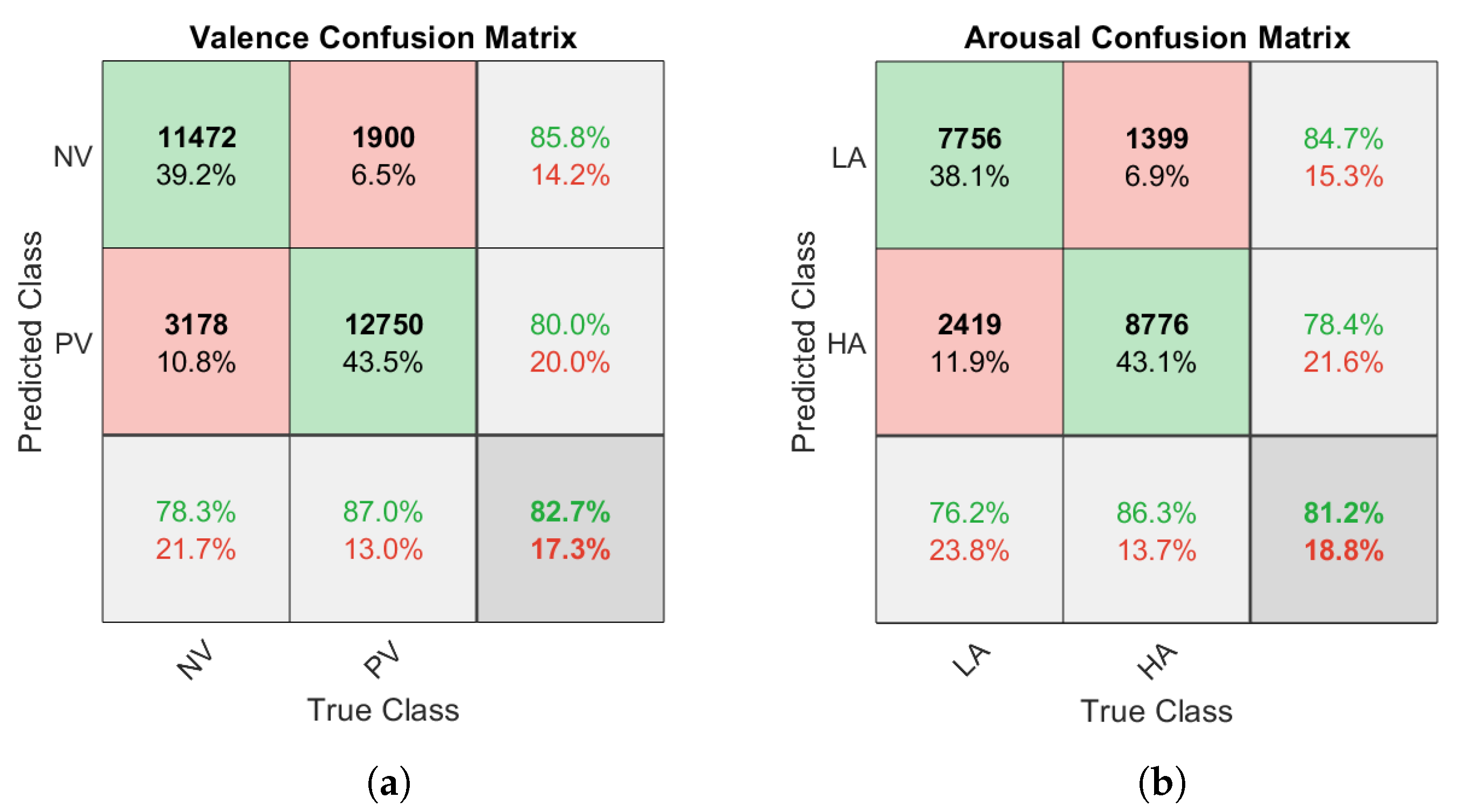
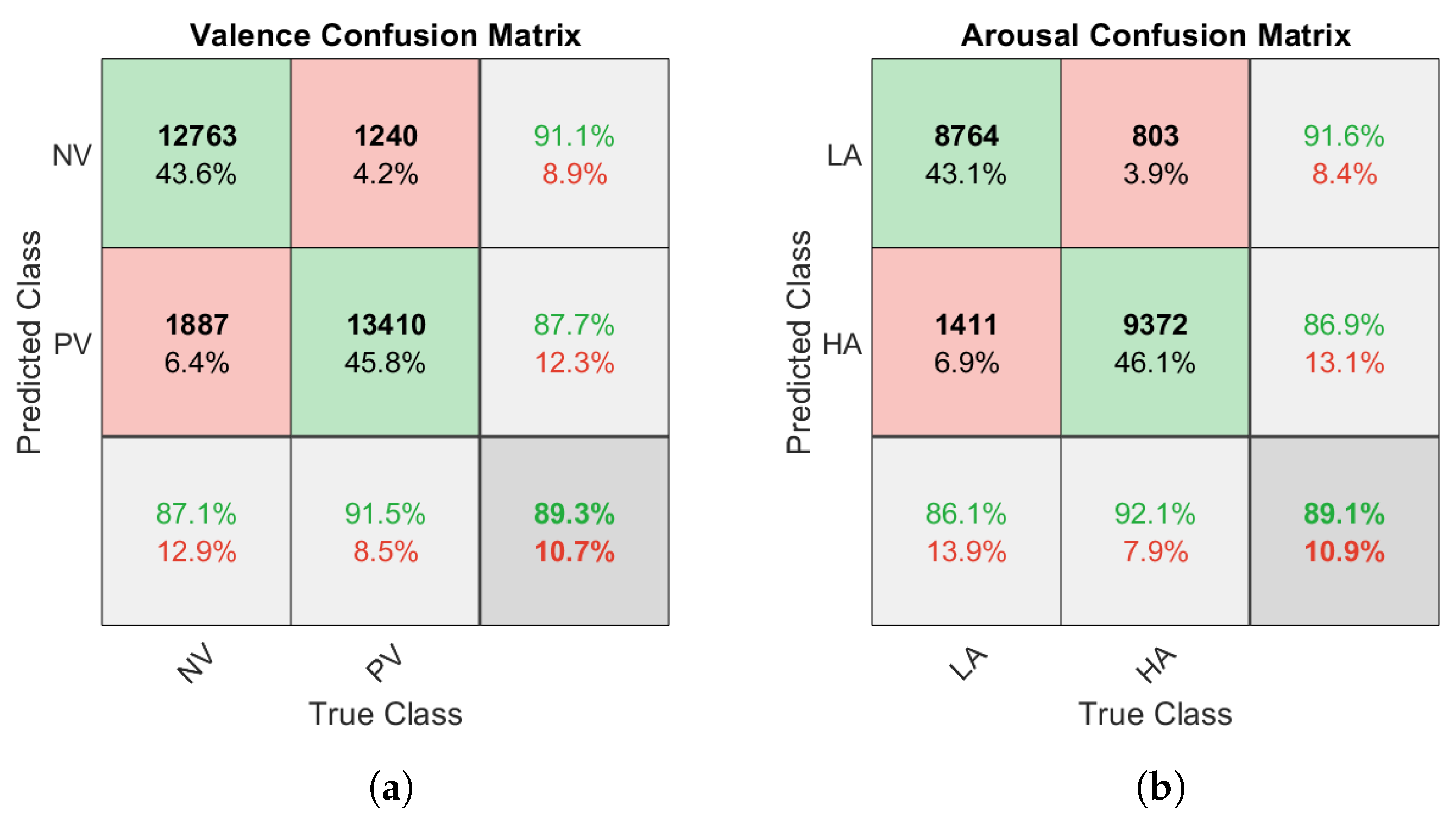
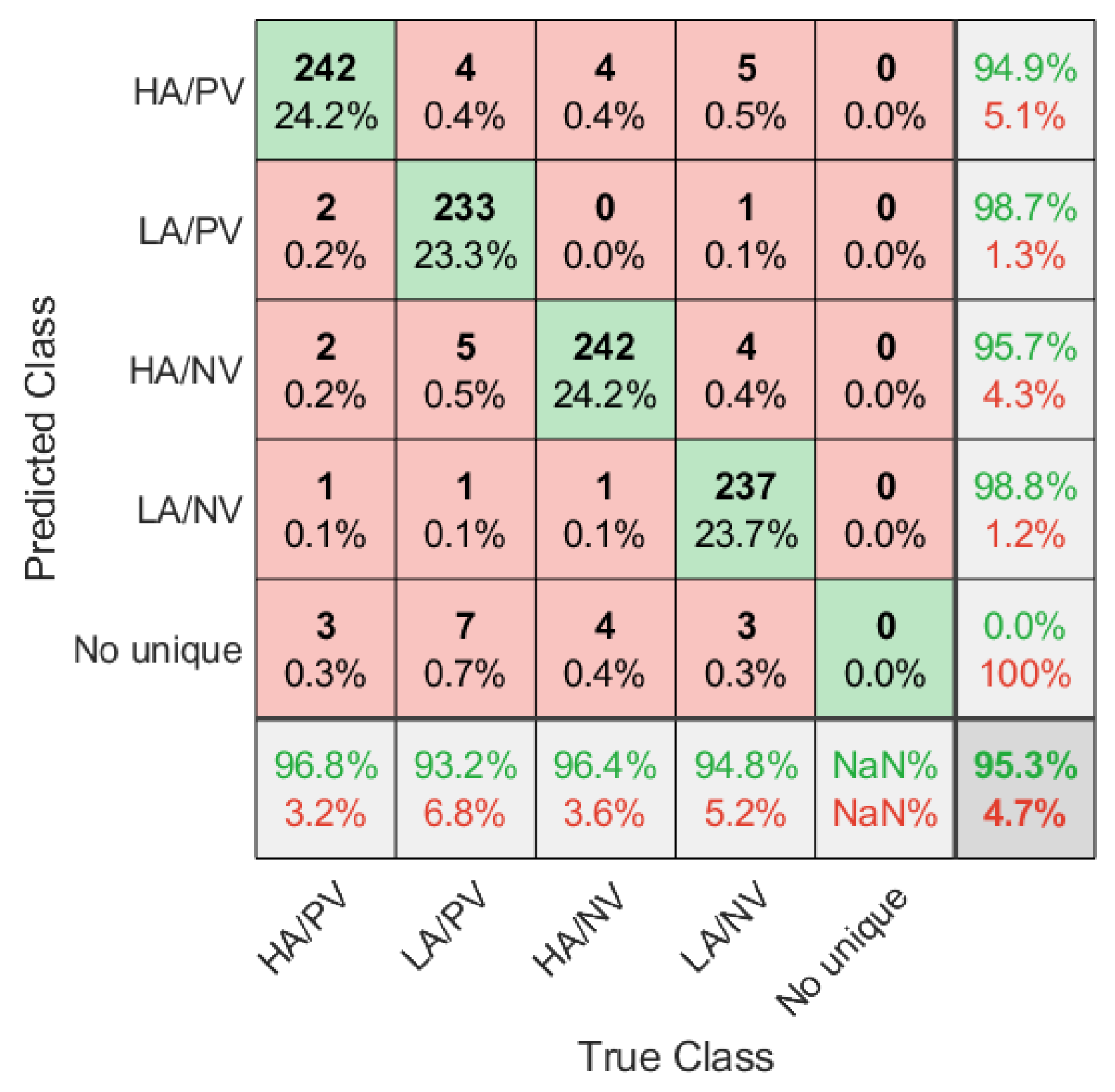
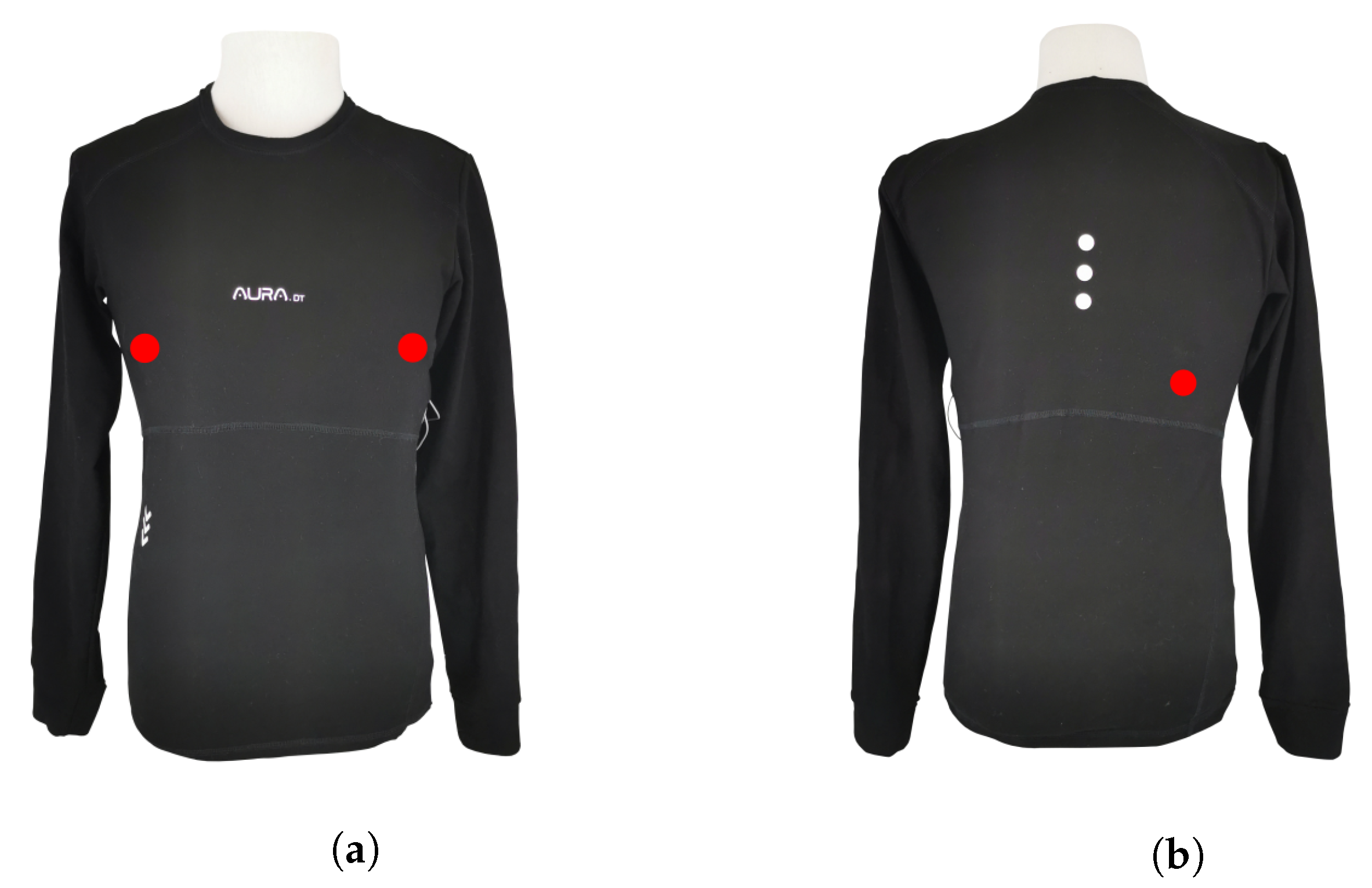

| Classifier | Valence | Arousal | ||||||
|---|---|---|---|---|---|---|---|---|
| Time and Freq. Features | Wavelet Features | Time and Freq. Features | Wavelet Features | |||||
| Acc. | F1 | Acc. | F1 | Acc. | F1 | Acc. | F1 | |
| Decision Tree | 0.592 | 0.560 | 0.631 | 0.654 | 0.606 | 0.595 | 0.642 | 0.627 |
| Discriminant Analysis | 0.590 | 0.575 | 0.622 | 0.610 | 0.593 | 0.558 | 0.661 | 0.652 |
| Naïve Bayes | 0.526 | 0.381 | 0.602 | 0.614 | 0.577 | 0.509 | 0.618 | 0.615 |
| KNN | 0.566 | 0.603 | 0.827 | 0.834 | 0.572 | 0.601 | 0.812 | 0.821 |
| SVM | 0.597 | 0.556 | 0.629 | 0.612 | 0.584 | 0.499 | 0.667 | 0.654 |
| Ensemble | 0.588 | 0.593 | 0.893 | 0.896 | 0.587 | 0.595 | 0.891 | 0.894 |
| Mean | 0.577 | 0.545 | 0.701 | 0.703 | 0.587 | 0.559 | 0.715 | 0.711 |
| Classifier | Time and Freq. Features | Wavelet Features | ||
|---|---|---|---|---|
| Acc. | F1 | Acc. | F1 | |
| Decision Tree | 0.690 | 0.673 | 0.432 | 0.673 |
| Discriminant Analysis | 0.361 | 0.357 | 0.527 | 0.357 |
| Naïve Bayes | 0.276 | 0.193 | 0.267 | 0.193 |
| KKN | 0.351 | 0.347 | 0.736 | 0.347 |
| L-SVM | 0.591 | 0.577 | 0.519 | 0.577 |
| Ensemble | 0.426 | 0.421 | 0.889 | 0.421 |
| Mean | 0.449 | 0.428 | 0.562 | 0.428 |
| Number of Components | Accuracy |
|---|---|
| 210 | 89.0% |
| 200 | 84.5% |
| 150 | 85.0% |
| 100 | 85.6% |
| 50 | 84.4% |
| Precision | Recall | F1-Score | |
|---|---|---|---|
| HA/PV | 0.853 | 0.905 | 0.879 |
| LA/PV | 0.895 | 0.851 | 0.872 |
| HA/NV | 0.883 | 0.926 | 0.904 |
| LA/NV | 0.916 | 0.861 | 0.888 |
| Mean | 0.887 | 0.886 | 0.886 |
| Classifier | Validation | Arousal | Valence | ||
|---|---|---|---|---|---|
| Acc. | F1 | Acc. | F1 | ||
| Naive Bayes [7] | LOSO | 0.69 | 0.545 | - | 0.551 |
| Nearest Neighbors [25] | N/R | - | 0.66 | 0.58 | 0.57 |
| Linear Discriminant [25] | N/R | 0.72 | 0.63 | 0.67 | 0.65 |
| Linear Support Vector [25] | N/R | 0.68 | 0.60 | 0.61 | 0.55 |
| Multilayer Perceptron [25] | N/R | 0.68 | 0.59 | 0.61 | 0.51 |
| AdaBoost [25] | N/R | 0.70 | 0.66 | 0.61 | 0.58 |
| Random Forest [25] | N/R | 0.68 | 0.67 | 0.59 | 0.59 |
| DCNN [25] | N/R | 0.81 | 0.76 | 0.71 | 0.68 |
| CNN w/o self-supervised [26] | 10 Fold | 0.837 | 0.828 | 0.809 | 0.808 |
| CNN self-supervised [26] | 10 Fold | 0.858 | 0.851 | 0.840 | 0.837 |
| XGBoost [27] | LOSO | - | 0.561 | - | 0.633 |
| Bayesian DL [23] | 10 Fold | - | - | 0.90 | 0.86 |
| KNN [24] | 10 Fold | 0.558 | - | 0.597 | - |
| KNN (this work) | 10 Fold | 0.888 | 0.821 | 0.889 | 0.834 |
| Ensemble (this work) | 10 Fold | 0.902 | 0.894 | 0.904 | 0.896 |
Publisher’s Note: MDPI stays neutral with regard to jurisdictional claims in published maps and institutional affiliations. |
© 2021 by the authors. Licensee MDPI, Basel, Switzerland. This article is an open access article distributed under the terms and conditions of the Creative Commons Attribution (CC BY) license (https://creativecommons.org/licenses/by/4.0/).
Share and Cite
Sepúlveda, A.; Castillo, F.; Palma, C.; Rodriguez-Fernandez, M. Emotion Recognition from ECG Signals Using Wavelet Scattering and Machine Learning. Appl. Sci. 2021, 11, 4945. https://doi.org/10.3390/app11114945
Sepúlveda A, Castillo F, Palma C, Rodriguez-Fernandez M. Emotion Recognition from ECG Signals Using Wavelet Scattering and Machine Learning. Applied Sciences. 2021; 11(11):4945. https://doi.org/10.3390/app11114945
Chicago/Turabian StyleSepúlveda, Axel, Francisco Castillo, Carlos Palma, and Maria Rodriguez-Fernandez. 2021. "Emotion Recognition from ECG Signals Using Wavelet Scattering and Machine Learning" Applied Sciences 11, no. 11: 4945. https://doi.org/10.3390/app11114945
APA StyleSepúlveda, A., Castillo, F., Palma, C., & Rodriguez-Fernandez, M. (2021). Emotion Recognition from ECG Signals Using Wavelet Scattering and Machine Learning. Applied Sciences, 11(11), 4945. https://doi.org/10.3390/app11114945







